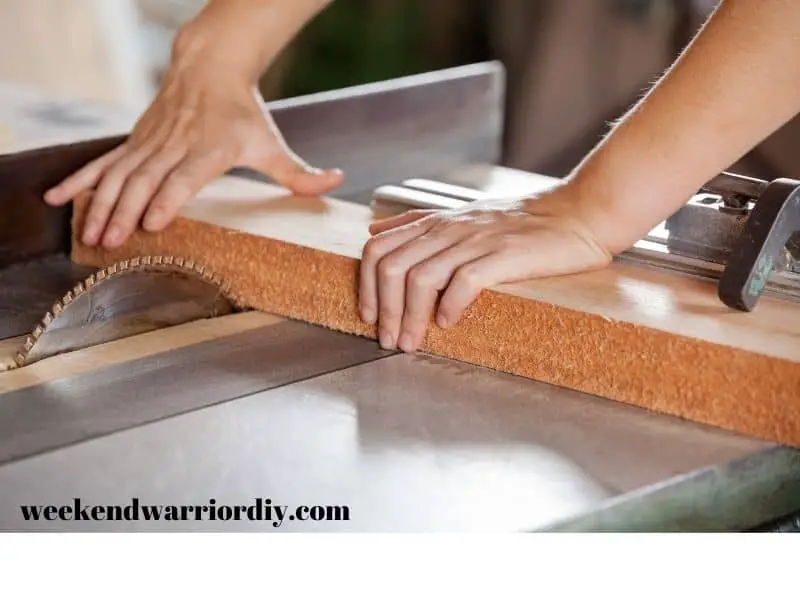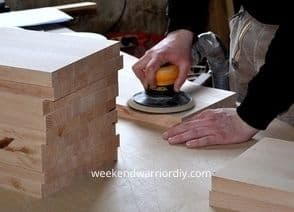Understanding which way your table saw blade turns and why will help you to use the power tool properly and safely. I know from my own experience that when I understood all of this, I was better qualified to use my table saw and that is my goal with this article…helping you get better as well.
Table saw blades turn clockwise towards the front of the table. Table saw motors are positioned so the blade turns clockwise and towards the front of the saw. This allows the table saw blade to cut into the wood as the wood is pushed from the front of the table saw towards the back.
Table saw blades turning clockwise probably isn’t a big surprise to you. Have you ever looked to see where your table saw motor is? I’m guessing you probably have- now that you know they are positioned under the deck of your table saw to allow the blade to turn towards the front of the saw. As simple as something turning clockwise seems to be, it really is a good idea to get to know your power tools to understand how they work as best as possible.
So, if you want to learn more, then let’s begin!
Which Way Does a Table Saw Blade Go?
When you are installing a new table saw blade, we now know it turns towards the front of the table saw. This means the teeth on the blade need to be pointing towards the front of the saw.
This placement allows the saws blade to cut into the wood, which is obviously what you want.
There are only two ways a saw blade can be placed on the arbor, so it shouldn’t be hard to figure it out.
With some table saw blades, I can understand it might be hard for someone new to the hobby to know which way the blade goes as the teeth are almost pointing straight out from the center.
All blades, however, have saw teeth that point or lean in one direction. Once you identify the direction, then you’ll know which way the blade should be installed. Table saw blade teeth should point to the front of the saw.

Is a Table Saw Reverse Thread?
The way your arbor nut threads onto the arbor will depend on the positioning of the table saw’s motor.
The main reason this is so important is because the nut will need to tighten as it turns. Since the blade turns clockwise, the nut will have to turn in the opposite direction to ensure it stays tight.
If the nut turned with the blade, that would cause the blade to come loose and therefore be dangerous…which is definitely not something we want to happen!
The answer to the question as to whether a table saw thread is reversed or not is ‘it depends’ on which way the arbor post is pointing. Let me explain…
The following examples are assuming you are standing in front of (or facing) the table saw.
- If the table saw motor is on the left side of the table, the arbor nut would thread clockwise. When the blade is turning towards the front of the table, the arbor nut would be tightening against it.
- When the table saw motor is on the right side of the table, this means the arbor nut will have to turn counterclockwise (reverse thread) on the arbor post. This will keep the nut tight.
- Some larger table saws have a motor that hangs on the back of the table and is a belt drive. To determine whether it is a reverse thread or not, you’ll have to turn the nut onto the post to see. If the nut turns on counterclockwise, then it’s a reverse thread.
Can You Tilt the Blade on a Table Saw?
Yes, a table saw blade (arbor) can be tilted.
It’ll depend on which side the motor is on as far as from which direction it tilts, but you should be able to tilt the blade.
I’m not aware of which tilt direction is the best. From my own experience, I don’t think it really matters which side the blade tilts from as long as it cuts the wood as needed.
Conclusion
Just to quickly wrap-up this article, I wanted to say that it’s very important you get to know your power tools. You should know which ways blades turn and any other pertinent information that will help keep you safe.
Being familiar with power tools like a table saw also helps you to improve as a woodworker.
I hope this article has been of help to you. Thanks for reading and good luck with your future projects.
Related Posts
Woodworking When You Live in an Apartment (How to Do it Right)!


